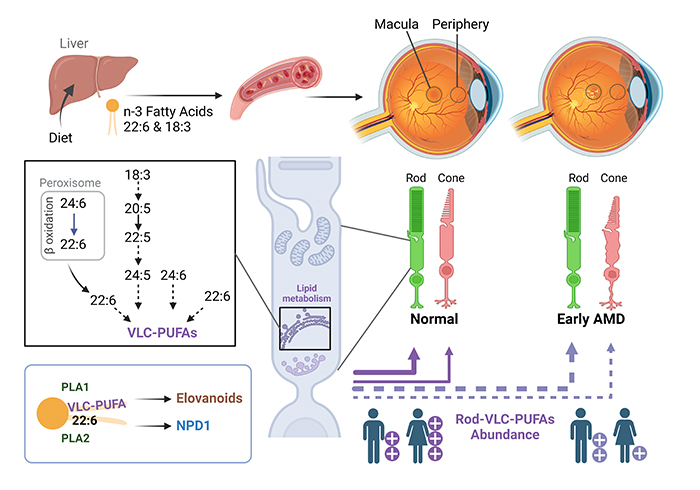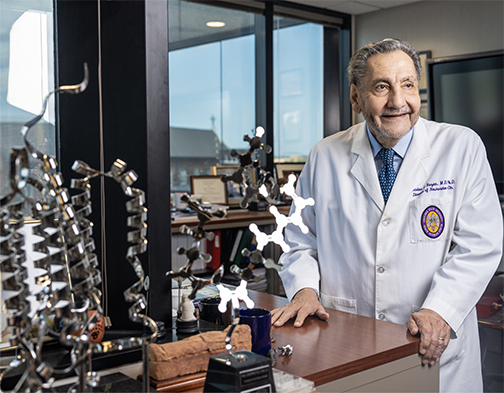LSU Health New Orleans Researchers Discover a Key Failure in AMD that May Lead to Progression & Vision Loss
September 11, 2023

The study shows that AMD decreases peripheral retinal docosahexaenoic acid (DHA) 22:6 in rod photoreceptor cells, limiting the elongation of fatty acids to form very-long-chain polyunsaturated fatty acids (VLC-PUFAs). VLC-PUFAs are precursors of elovanoids, bioactive chemical messengers made from omega-3 very- long-chain polyunsaturated fatty acids. Elovanoids, discovered by the Bazan lab, have been shown to restore the structure and integrity of damaged photoreceptor cells by repairing, remodeling and regenerating healthy cells. The loss of the neuroprotective precursors of elovanoids in the retina periphery from AMD facilitates uncompensated stress and cell loss.
The research team also found major differences between genders. According to the National Institutes of Health, 66% of AMD-affected persons are female. Females have higher DHA 22:6 than males because of estrogen effects. As they age and estrogen decreases, so does DHA 22:6, and as a result, women can become increasingly susceptible to retinal degeneration.

According to the National Eye Institute, age-related macular degeneration (AMD) is an eye disease that can blur central vision. It happens when aging causes damage to the macula — the part of the eye that controls sharp, straight-ahead vision. The macula is part of the retina (the light-sensitive tissue at the back of the eye). AMD is a leading cause of vision loss for older adults. AMD doesn’t cause complete blindness, but losing your central vision can make it harder to see faces, read, drive, or do close-up work like cooking or fixing things around the house.
According to the Bright Focus Foundation, nearly 20 million US adults have some form of age-related macular degeneration. An estimated 18 million people aged 40 and older were living with early-stage macular degeneration in 2019, and 1.49 million had late-stage macular degeneration. Around 200 million people worldwide are thought to be living with AMD, a number expected to reach 288 million by 2040. Age is a prominent risk factor for age-related macular degeneration. The risk of getting advanced age-related macular degeneration increases from 2% for those ages 50-59, to nearly 30% for those over the age of 75. The direct health care costs of visual impairment due to age-related macular degeneration in the U.S., Canada, and Cuba are estimated at $98 billion.Other authors include Drs. William Gordon, Marie-Audrey Kautzmann, and Bok Kyoo Jun, along with Megan Cothern at LSU Health New Orleans’ Neuroscience Center of Excellence and Dr. Zhide Fang at LSU Health New Orleans School of Public Health.
The research was supported by the National Eye Institute of the National Institutes of Health and the Eye, Ear, Nose & Throat Foundation of New Orleans.______________________________________________________________________________________________________________ LSU Health Sciences Center New Orleans (LSU Health New Orleans) educates Louisiana's health care professionals. The state's health sciences university leader, LSU Health New Orleans includes a School of Medicine with campuses in Baton Rouge and Lafayette, the state's only School of Dentistry, Louisiana's only public School of Public Health, and Schools of Allied Health Professions, Nursing, and Graduate Studies. LSU Health New Orleans faculty take care of patients in public and private hospitals and clinics throughout the region. In the vanguard of biosciences research, the LSU Health New Orleans research enterprise generates jobs and enormous annual economic impact. LSU Health New Orleans faculty have made lifesaving discoveries and continue to work to prevent, advance treatment or cure disease. To learn more, visit http://www.lsuhsc.edu, http://www.twitter.com/LSUHealthNO, or http://www.facebook.com/LSUHSC.
